Business Growth Plan: Ansoff, Funding, & Exit Strategies Explored
VerifiedAdded on 2023/06/08
|22
|6330
|490
Report
AI Summary
This report provides a comprehensive analysis of growth planning for businesses, focusing on evaluating growth opportunities and funding strategies. It uses Porter's Generic Strategies and Ansoff's Growth Matrix to explore competitive advantages and market expansion. The report examines potential funding sources, their benefits, and drawbacks, and presents a detailed business plan for the Bridge House Hotel, including strategic objectives, financial information, and a SWOT analysis. Finally, it discusses exit and succession options for small businesses, evaluating their benefits and drawbacks to provide a well-rounded perspective on business growth and sustainability. Desklib provides students access to this and many other solved assignments.

Planning For Growth
Paraphrase This Document
Need a fresh take? Get an instant paraphrase of this document with our AI Paraphraser
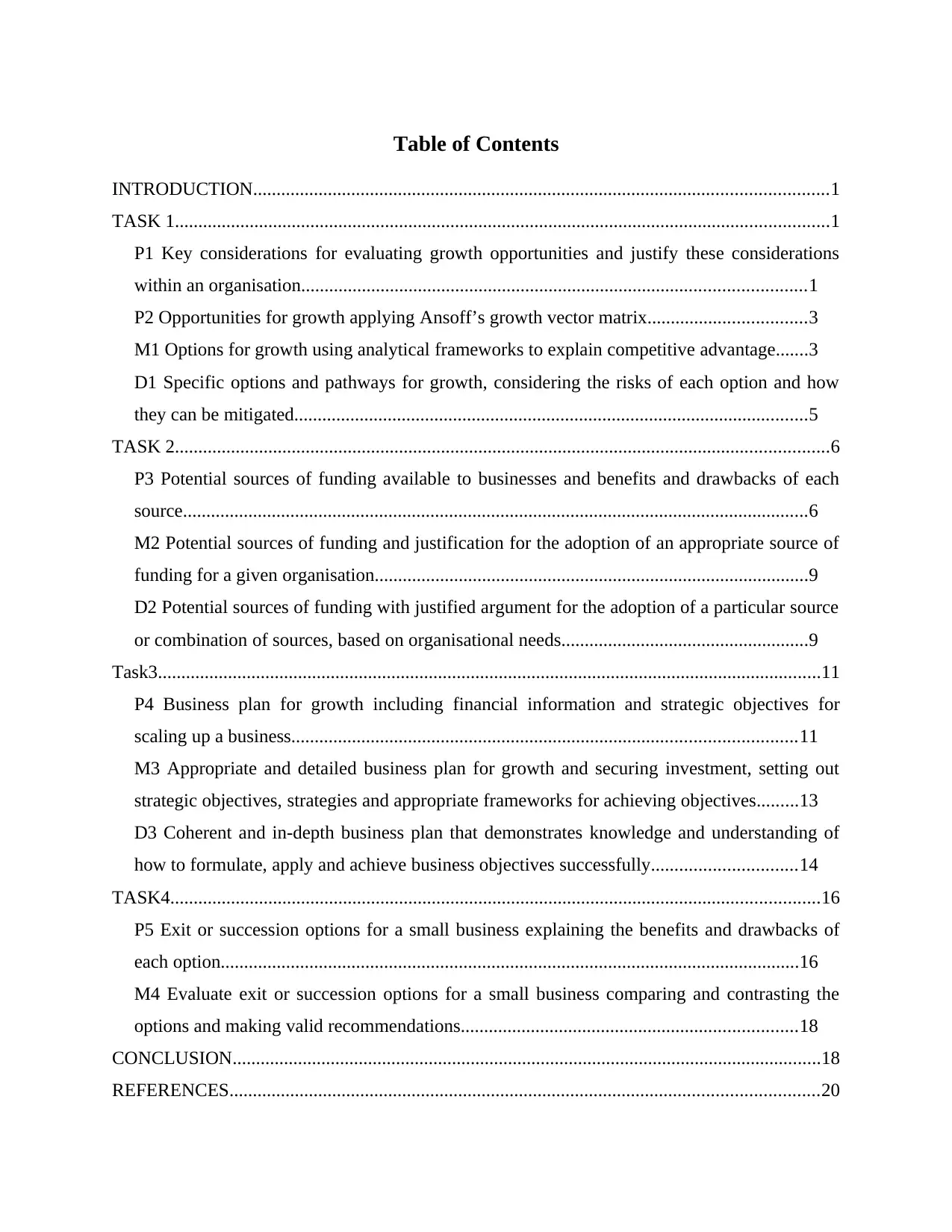
Table of Contents
INTRODUCTION...........................................................................................................................1
TASK 1............................................................................................................................................1
P1 Key considerations for evaluating growth opportunities and justify these considerations
within an organisation............................................................................................................1
P2 Opportunities for growth applying Ansoff’s growth vector matrix..................................3
M1 Options for growth using analytical frameworks to explain competitive advantage.......3
D1 Specific options and pathways for growth, considering the risks of each option and how
they can be mitigated..............................................................................................................5
TASK 2............................................................................................................................................6
P3 Potential sources of funding available to businesses and benefits and drawbacks of each
source......................................................................................................................................6
M2 Potential sources of funding and justification for the adoption of an appropriate source of
funding for a given organisation.............................................................................................9
D2 Potential sources of funding with justified argument for the adoption of a particular source
or combination of sources, based on organisational needs.....................................................9
Task3..............................................................................................................................................11
P4 Business plan for growth including financial information and strategic objectives for
scaling up a business............................................................................................................11
M3 Appropriate and detailed business plan for growth and securing investment, setting out
strategic objectives, strategies and appropriate frameworks for achieving objectives.........13
D3 Coherent and in-depth business plan that demonstrates knowledge and understanding of
how to formulate, apply and achieve business objectives successfully...............................14
TASK4...........................................................................................................................................16
P5 Exit or succession options for a small business explaining the benefits and drawbacks of
each option............................................................................................................................16
M4 Evaluate exit or succession options for a small business comparing and contrasting the
options and making valid recommendations........................................................................18
CONCLUSION..............................................................................................................................18
REFERENCES..............................................................................................................................20
INTRODUCTION...........................................................................................................................1
TASK 1............................................................................................................................................1
P1 Key considerations for evaluating growth opportunities and justify these considerations
within an organisation............................................................................................................1
P2 Opportunities for growth applying Ansoff’s growth vector matrix..................................3
M1 Options for growth using analytical frameworks to explain competitive advantage.......3
D1 Specific options and pathways for growth, considering the risks of each option and how
they can be mitigated..............................................................................................................5
TASK 2............................................................................................................................................6
P3 Potential sources of funding available to businesses and benefits and drawbacks of each
source......................................................................................................................................6
M2 Potential sources of funding and justification for the adoption of an appropriate source of
funding for a given organisation.............................................................................................9
D2 Potential sources of funding with justified argument for the adoption of a particular source
or combination of sources, based on organisational needs.....................................................9
Task3..............................................................................................................................................11
P4 Business plan for growth including financial information and strategic objectives for
scaling up a business............................................................................................................11
M3 Appropriate and detailed business plan for growth and securing investment, setting out
strategic objectives, strategies and appropriate frameworks for achieving objectives.........13
D3 Coherent and in-depth business plan that demonstrates knowledge and understanding of
how to formulate, apply and achieve business objectives successfully...............................14
TASK4...........................................................................................................................................16
P5 Exit or succession options for a small business explaining the benefits and drawbacks of
each option............................................................................................................................16
M4 Evaluate exit or succession options for a small business comparing and contrasting the
options and making valid recommendations........................................................................18
CONCLUSION..............................................................................................................................18
REFERENCES..............................................................................................................................20

⊘ This is a preview!⊘
Do you want full access?
Subscribe today to unlock all pages.

Trusted by 1+ million students worldwide
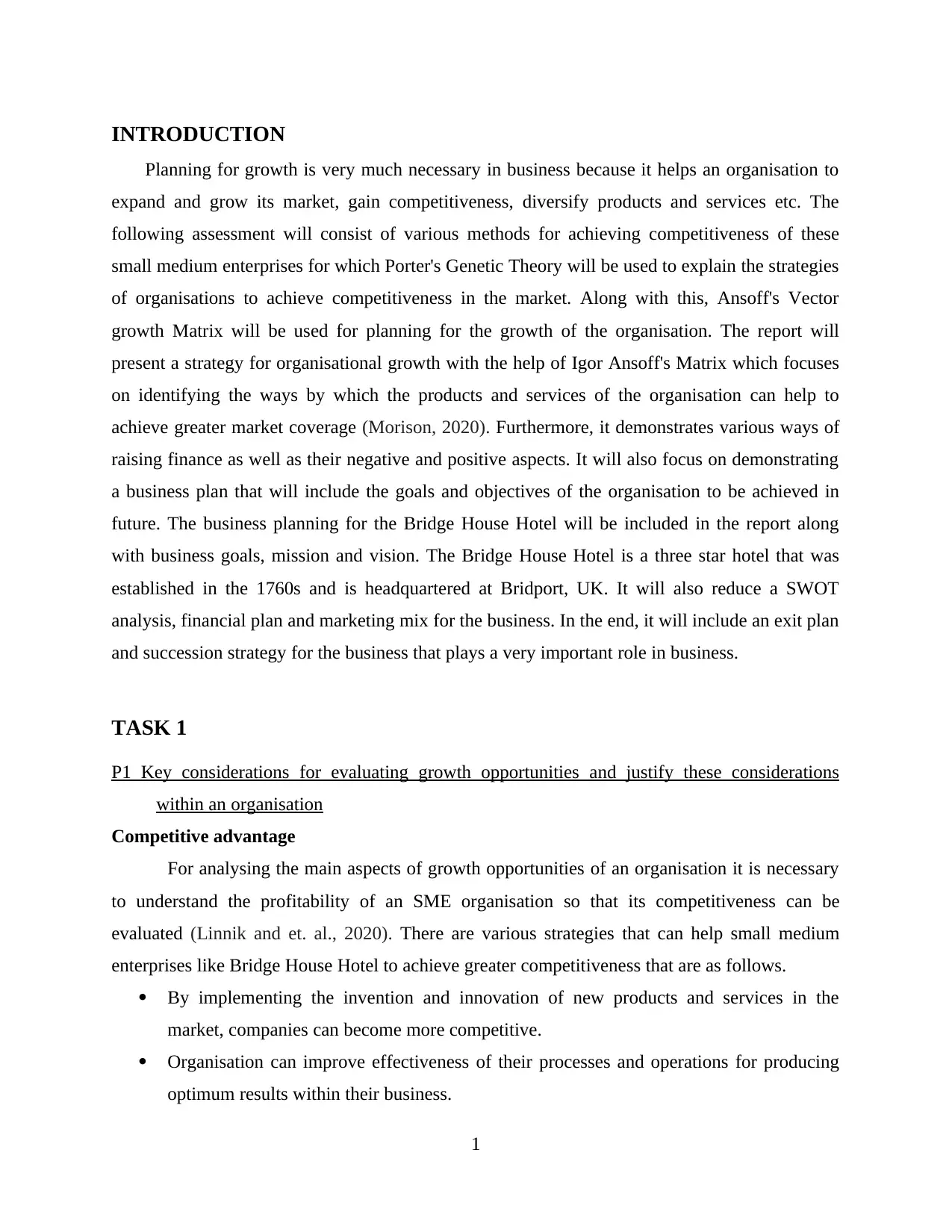
INTRODUCTION
Planning for growth is very much necessary in business because it helps an organisation to
expand and grow its market, gain competitiveness, diversify products and services etc. The
following assessment will consist of various methods for achieving competitiveness of these
small medium enterprises for which Porter's Genetic Theory will be used to explain the strategies
of organisations to achieve competitiveness in the market. Along with this, Ansoff's Vector
growth Matrix will be used for planning for the growth of the organisation. The report will
present a strategy for organisational growth with the help of Igor Ansoff's Matrix which focuses
on identifying the ways by which the products and services of the organisation can help to
achieve greater market coverage (Morison, 2020). Furthermore, it demonstrates various ways of
raising finance as well as their negative and positive aspects. It will also focus on demonstrating
a business plan that will include the goals and objectives of the organisation to be achieved in
future. The business planning for the Bridge House Hotel will be included in the report along
with business goals, mission and vision. The Bridge House Hotel is a three star hotel that was
established in the 1760s and is headquartered at Bridport, UK. It will also reduce a SWOT
analysis, financial plan and marketing mix for the business. In the end, it will include an exit plan
and succession strategy for the business that plays a very important role in business.
TASK 1
P1 Key considerations for evaluating growth opportunities and justify these considerations
within an organisation
Competitive advantage
For analysing the main aspects of growth opportunities of an organisation it is necessary
to understand the profitability of an SME organisation so that its competitiveness can be
evaluated (Linnik and et. al., 2020). There are various strategies that can help small medium
enterprises like Bridge House Hotel to achieve greater competitiveness that are as follows.
By implementing the invention and innovation of new products and services in the
market, companies can become more competitive.
Organisation can improve effectiveness of their processes and operations for producing
optimum results within their business.
1
Planning for growth is very much necessary in business because it helps an organisation to
expand and grow its market, gain competitiveness, diversify products and services etc. The
following assessment will consist of various methods for achieving competitiveness of these
small medium enterprises for which Porter's Genetic Theory will be used to explain the strategies
of organisations to achieve competitiveness in the market. Along with this, Ansoff's Vector
growth Matrix will be used for planning for the growth of the organisation. The report will
present a strategy for organisational growth with the help of Igor Ansoff's Matrix which focuses
on identifying the ways by which the products and services of the organisation can help to
achieve greater market coverage (Morison, 2020). Furthermore, it demonstrates various ways of
raising finance as well as their negative and positive aspects. It will also focus on demonstrating
a business plan that will include the goals and objectives of the organisation to be achieved in
future. The business planning for the Bridge House Hotel will be included in the report along
with business goals, mission and vision. The Bridge House Hotel is a three star hotel that was
established in the 1760s and is headquartered at Bridport, UK. It will also reduce a SWOT
analysis, financial plan and marketing mix for the business. In the end, it will include an exit plan
and succession strategy for the business that plays a very important role in business.
TASK 1
P1 Key considerations for evaluating growth opportunities and justify these considerations
within an organisation
Competitive advantage
For analysing the main aspects of growth opportunities of an organisation it is necessary
to understand the profitability of an SME organisation so that its competitiveness can be
evaluated (Linnik and et. al., 2020). There are various strategies that can help small medium
enterprises like Bridge House Hotel to achieve greater competitiveness that are as follows.
By implementing the invention and innovation of new products and services in the
market, companies can become more competitive.
Organisation can improve effectiveness of their processes and operations for producing
optimum results within their business.
1
Paraphrase This Document
Need a fresh take? Get an instant paraphrase of this document with our AI Paraphraser
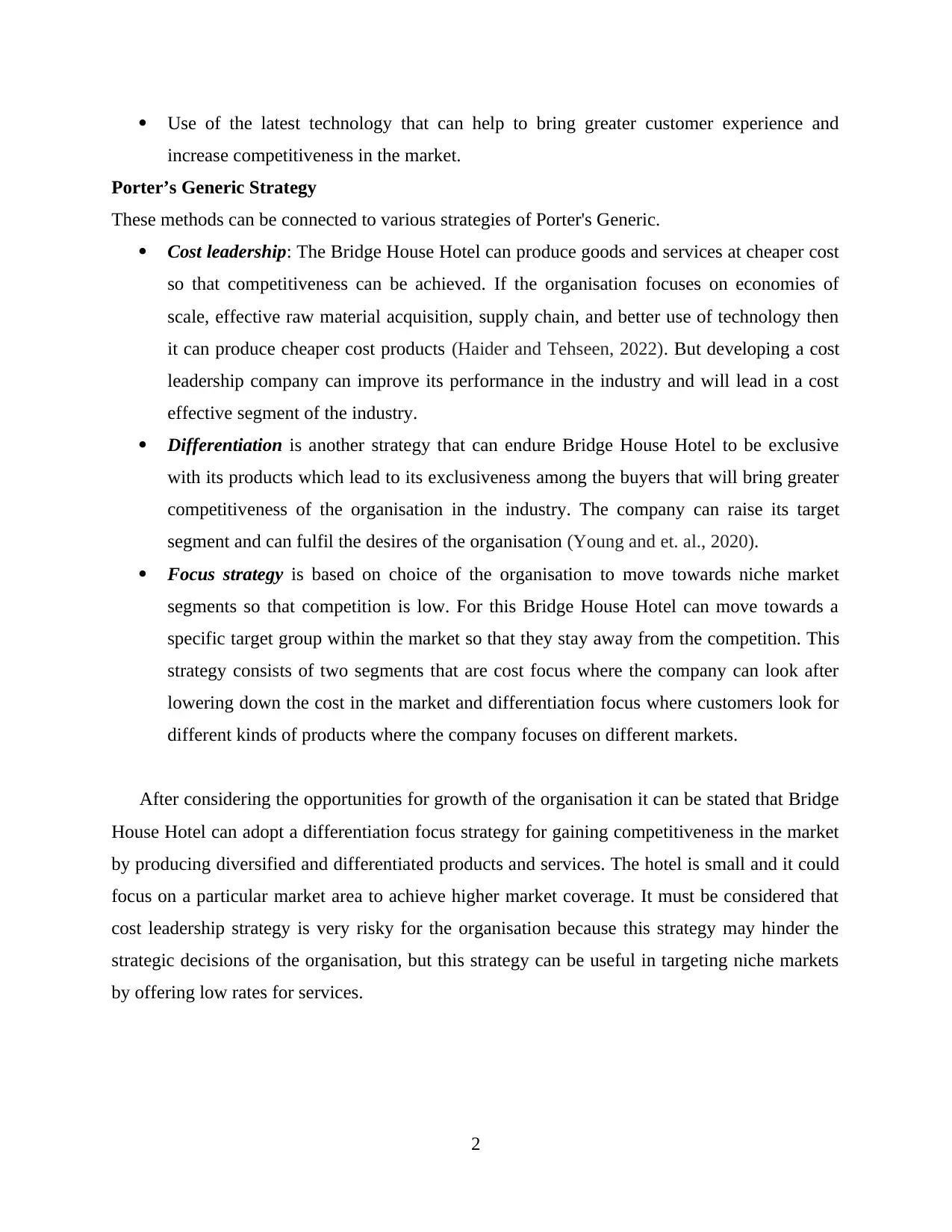
Use of the latest technology that can help to bring greater customer experience and
increase competitiveness in the market.
Porter’s Generic Strategy
These methods can be connected to various strategies of Porter's Generic.
Cost leadership: The Bridge House Hotel can produce goods and services at cheaper cost
so that competitiveness can be achieved. If the organisation focuses on economies of
scale, effective raw material acquisition, supply chain, and better use of technology then
it can produce cheaper cost products (Haider and Tehseen, 2022). But developing a cost
leadership company can improve its performance in the industry and will lead in a cost
effective segment of the industry.
Differentiation is another strategy that can endure Bridge House Hotel to be exclusive
with its products which lead to its exclusiveness among the buyers that will bring greater
competitiveness of the organisation in the industry. The company can raise its target
segment and can fulfil the desires of the organisation (Young and et. al., 2020).
Focus strategy is based on choice of the organisation to move towards niche market
segments so that competition is low. For this Bridge House Hotel can move towards a
specific target group within the market so that they stay away from the competition. This
strategy consists of two segments that are cost focus where the company can look after
lowering down the cost in the market and differentiation focus where customers look for
different kinds of products where the company focuses on different markets.
After considering the opportunities for growth of the organisation it can be stated that Bridge
House Hotel can adopt a differentiation focus strategy for gaining competitiveness in the market
by producing diversified and differentiated products and services. The hotel is small and it could
focus on a particular market area to achieve higher market coverage. It must be considered that
cost leadership strategy is very risky for the organisation because this strategy may hinder the
strategic decisions of the organisation, but this strategy can be useful in targeting niche markets
by offering low rates for services.
2
increase competitiveness in the market.
Porter’s Generic Strategy
These methods can be connected to various strategies of Porter's Generic.
Cost leadership: The Bridge House Hotel can produce goods and services at cheaper cost
so that competitiveness can be achieved. If the organisation focuses on economies of
scale, effective raw material acquisition, supply chain, and better use of technology then
it can produce cheaper cost products (Haider and Tehseen, 2022). But developing a cost
leadership company can improve its performance in the industry and will lead in a cost
effective segment of the industry.
Differentiation is another strategy that can endure Bridge House Hotel to be exclusive
with its products which lead to its exclusiveness among the buyers that will bring greater
competitiveness of the organisation in the industry. The company can raise its target
segment and can fulfil the desires of the organisation (Young and et. al., 2020).
Focus strategy is based on choice of the organisation to move towards niche market
segments so that competition is low. For this Bridge House Hotel can move towards a
specific target group within the market so that they stay away from the competition. This
strategy consists of two segments that are cost focus where the company can look after
lowering down the cost in the market and differentiation focus where customers look for
different kinds of products where the company focuses on different markets.
After considering the opportunities for growth of the organisation it can be stated that Bridge
House Hotel can adopt a differentiation focus strategy for gaining competitiveness in the market
by producing diversified and differentiated products and services. The hotel is small and it could
focus on a particular market area to achieve higher market coverage. It must be considered that
cost leadership strategy is very risky for the organisation because this strategy may hinder the
strategic decisions of the organisation, but this strategy can be useful in targeting niche markets
by offering low rates for services.
2

P2 Opportunities for growth applying Ansoff’s growth vector matrix
Igor Ansoff introduced a growth matrix so that an organisation can achieve greater
competitive strength by using various growth strategies. This matrix mainly synchronises certain
methods by which an organisation could achieve growth in the market by using existing or new
products in the markets (Olesen, 2022).
Market penetration is focused towards improving the range of existing products to cover
a greater market area so that organisations can achieve opportunities for growth in your
market. For instance, fast moving food counters within the UK have achieved huge
business profits by using market penetration.
Market development is helpful for SME organisations because it can achieve a greater
level of growth by focusing on the existing market area. The SMEs throughout the world
have adopted this strategy for achieving competitiveness in their existing market area. It
is also discovered in the SME ITC companies that they use this strategy to achieve
competitiveness in the existing market.
Product development is a strategy where an organisation tries to develop a complete new
product and focuses on placing that product in the existing market so that it can achieve
greater competitive advantage (Rienzo and Chen, 2018).
Differentiation is a completely dynamic strategy that was introduced by Ansoff because
in this method the organisation tries to achieve competitiveness in the New Market by
introducing new products or services.
M1 Options for growth using analytical frameworks to explain competitive advantage
To analyse the major intrinsic and extrinsic factors that affect the competitiveness within
Bridge House Hotel certain frameworks like SWOT, PEST and Porter’s five Forces analysis can
be used.
SWOT Analysis
Strengths Weaknesses
Higher competitiveness due to positive
culture of the business
Advancement of technology helps to
provide better customer experience and
Increasing turnover of the employees
Chances of increased workload due to
improper management within the
3
Igor Ansoff introduced a growth matrix so that an organisation can achieve greater
competitive strength by using various growth strategies. This matrix mainly synchronises certain
methods by which an organisation could achieve growth in the market by using existing or new
products in the markets (Olesen, 2022).
Market penetration is focused towards improving the range of existing products to cover
a greater market area so that organisations can achieve opportunities for growth in your
market. For instance, fast moving food counters within the UK have achieved huge
business profits by using market penetration.
Market development is helpful for SME organisations because it can achieve a greater
level of growth by focusing on the existing market area. The SMEs throughout the world
have adopted this strategy for achieving competitiveness in their existing market area. It
is also discovered in the SME ITC companies that they use this strategy to achieve
competitiveness in the existing market.
Product development is a strategy where an organisation tries to develop a complete new
product and focuses on placing that product in the existing market so that it can achieve
greater competitive advantage (Rienzo and Chen, 2018).
Differentiation is a completely dynamic strategy that was introduced by Ansoff because
in this method the organisation tries to achieve competitiveness in the New Market by
introducing new products or services.
M1 Options for growth using analytical frameworks to explain competitive advantage
To analyse the major intrinsic and extrinsic factors that affect the competitiveness within
Bridge House Hotel certain frameworks like SWOT, PEST and Porter’s five Forces analysis can
be used.
SWOT Analysis
Strengths Weaknesses
Higher competitiveness due to positive
culture of the business
Advancement of technology helps to
provide better customer experience and
Increasing turnover of the employees
Chances of increased workload due to
improper management within the
3
⊘ This is a preview!⊘
Do you want full access?
Subscribe today to unlock all pages.

Trusted by 1+ million students worldwide

attracts many customers
Well-furnished rooms and soothing
location of the Hotel also attracts many
tourists
organisation (Sørensen, 2018).
Opportunities Threats
Better opportunities for using
technological advancement and digital
technology
The population of the UK and increased
international tourism provides greater
growth opportunities for the
organisation
Improper management of finances and
liquid assets
Rising number of competitors in the
market
PEST Analysis
For understanding the competitive advantage and examining the hotel industry in the UK
where Bridge House Hotel is operational, Pest Analysis can be used.
Political environment within the UK is very much positive for the growth of
organisations in the country. Certain problems in the political environment of the UK that
has affected the hotel industry are Brexit and government restrictions during the Covid-
19 crises.
Economic conditions include several factors like tourism, value added tax, taxation
policies etc. that affect the operations of SMEs within a nation (Mazzarol and Reboud,
2020). The UK economy provides support to the growth of travel and tourism as well as
helps the small medium enterprises to grow their market.
Social factors mainly consist of the aspects within the society like culture, tradition etc.
that affects customer experience. Within the UK, the socio-cultural environment is very
dynamic and people live together and happily with each other, which makes it suitable for
hospitality organisations to achieve better competition in the market.
Technology advancement is one of the major factors within the hospitality industry. It is
very necessary that organisations within this sector must adopt latest innovations so that
they can achieve higher market coverage and success in future.
4
Well-furnished rooms and soothing
location of the Hotel also attracts many
tourists
organisation (Sørensen, 2018).
Opportunities Threats
Better opportunities for using
technological advancement and digital
technology
The population of the UK and increased
international tourism provides greater
growth opportunities for the
organisation
Improper management of finances and
liquid assets
Rising number of competitors in the
market
PEST Analysis
For understanding the competitive advantage and examining the hotel industry in the UK
where Bridge House Hotel is operational, Pest Analysis can be used.
Political environment within the UK is very much positive for the growth of
organisations in the country. Certain problems in the political environment of the UK that
has affected the hotel industry are Brexit and government restrictions during the Covid-
19 crises.
Economic conditions include several factors like tourism, value added tax, taxation
policies etc. that affect the operations of SMEs within a nation (Mazzarol and Reboud,
2020). The UK economy provides support to the growth of travel and tourism as well as
helps the small medium enterprises to grow their market.
Social factors mainly consist of the aspects within the society like culture, tradition etc.
that affects customer experience. Within the UK, the socio-cultural environment is very
dynamic and people live together and happily with each other, which makes it suitable for
hospitality organisations to achieve better competition in the market.
Technology advancement is one of the major factors within the hospitality industry. It is
very necessary that organisations within this sector must adopt latest innovations so that
they can achieve higher market coverage and success in future.
4
Paraphrase This Document
Need a fresh take? Get an instant paraphrase of this document with our AI Paraphraser
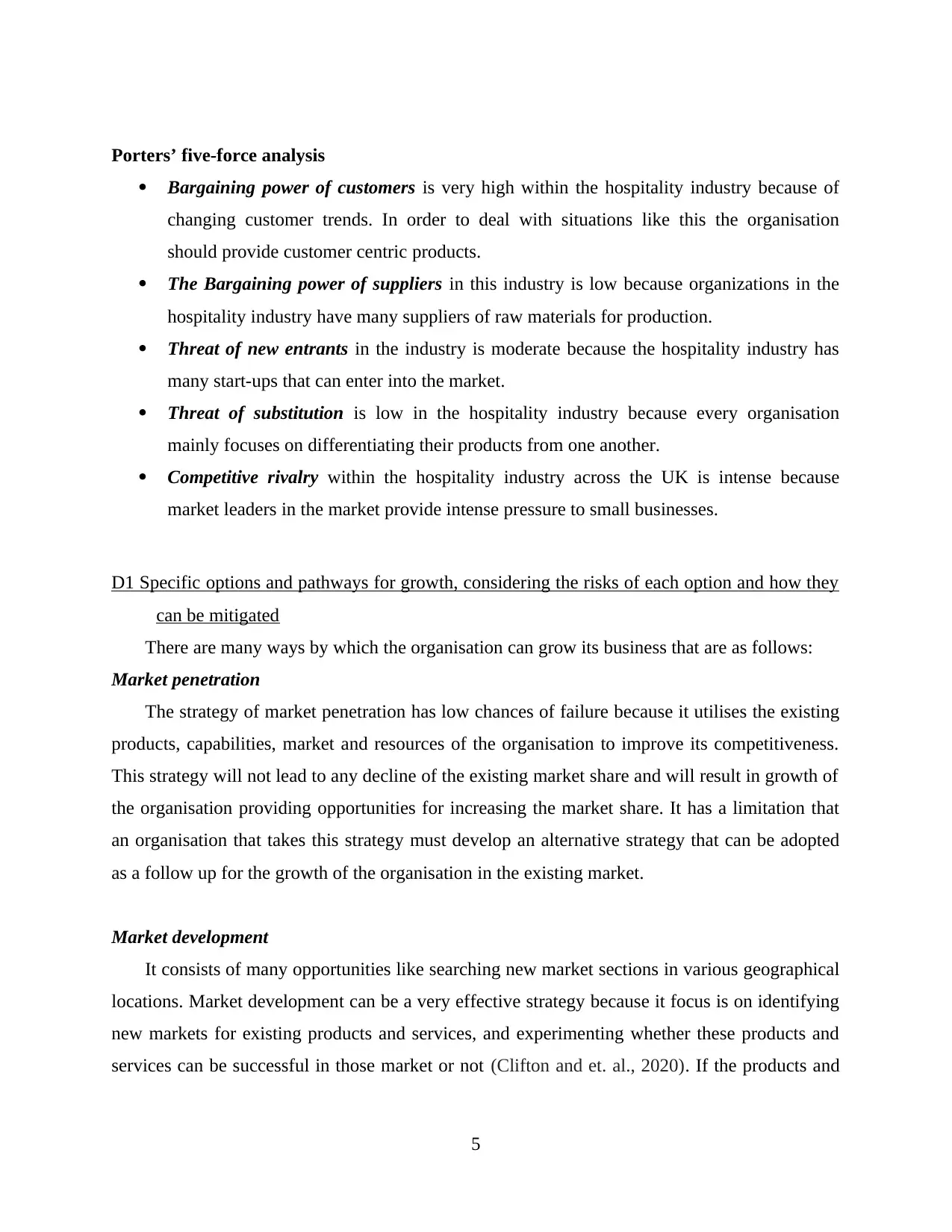
Porters’ five-force analysis
Bargaining power of customers is very high within the hospitality industry because of
changing customer trends. In order to deal with situations like this the organisation
should provide customer centric products.
The Bargaining power of suppliers in this industry is low because organizations in the
hospitality industry have many suppliers of raw materials for production.
Threat of new entrants in the industry is moderate because the hospitality industry has
many start-ups that can enter into the market.
Threat of substitution is low in the hospitality industry because every organisation
mainly focuses on differentiating their products from one another.
Competitive rivalry within the hospitality industry across the UK is intense because
market leaders in the market provide intense pressure to small businesses.
D1 Specific options and pathways for growth, considering the risks of each option and how they
can be mitigated
There are many ways by which the organisation can grow its business that are as follows:
Market penetration
The strategy of market penetration has low chances of failure because it utilises the existing
products, capabilities, market and resources of the organisation to improve its competitiveness.
This strategy will not lead to any decline of the existing market share and will result in growth of
the organisation providing opportunities for increasing the market share. It has a limitation that
an organisation that takes this strategy must develop an alternative strategy that can be adopted
as a follow up for the growth of the organisation in the existing market.
Market development
It consists of many opportunities like searching new market sections in various geographical
locations. Market development can be a very effective strategy because it focus is on identifying
new markets for existing products and services, and experimenting whether these products and
services can be successful in those market or not (Clifton and et. al., 2020). If the products and
5
Bargaining power of customers is very high within the hospitality industry because of
changing customer trends. In order to deal with situations like this the organisation
should provide customer centric products.
The Bargaining power of suppliers in this industry is low because organizations in the
hospitality industry have many suppliers of raw materials for production.
Threat of new entrants in the industry is moderate because the hospitality industry has
many start-ups that can enter into the market.
Threat of substitution is low in the hospitality industry because every organisation
mainly focuses on differentiating their products from one another.
Competitive rivalry within the hospitality industry across the UK is intense because
market leaders in the market provide intense pressure to small businesses.
D1 Specific options and pathways for growth, considering the risks of each option and how they
can be mitigated
There are many ways by which the organisation can grow its business that are as follows:
Market penetration
The strategy of market penetration has low chances of failure because it utilises the existing
products, capabilities, market and resources of the organisation to improve its competitiveness.
This strategy will not lead to any decline of the existing market share and will result in growth of
the organisation providing opportunities for increasing the market share. It has a limitation that
an organisation that takes this strategy must develop an alternative strategy that can be adopted
as a follow up for the growth of the organisation in the existing market.
Market development
It consists of many opportunities like searching new market sections in various geographical
locations. Market development can be a very effective strategy because it focus is on identifying
new markets for existing products and services, and experimenting whether these products and
services can be successful in those market or not (Clifton and et. al., 2020). If the products and
5

services are successful in a given market then strategy can be considered effective for increasing
market share of the organisation.
Product development
This strategy is most suitable for increasing market coverage by improving the customer
satisfaction in the existing market through development of new products and services. The
customers are always in search of new products and services in the market that can satisfy their
trending needs (Elashkar and et. al., 2021). Product development strategy is more risky because
inappropriate product development may lead to declination of existing customers and market
share.
Diversification
This strategy is considered as the most risky strategy because the organisation tries to
develop a new market area by introducing completely new products and services in a market. If
the strategy is successful then it can provide very high profits to the organisation and lead to
intensive increase in its market share and competitiveness. On the other hand if the strategy is not
appropriate and the new products and services do not attract the customers in the new market
then it may lead to loss of resources of the organisation and lower down the profits (Shpak and
et. al., 2020).
TASK 2
P3 Potential sources of funding available to businesses and benefits and drawbacks of each
source
There are various sources of funds for developing SMEs that may be from internal sources
or external sources that are elaborate below. The benefits and drawbacks of these sources of
finance are elaborate below.
Crowd funding is one of the sources of raising finance for the business where the finance is
arranged from a large number of people typically by using traditional and modern means like
raising funds from people and companies stakeholders or by using the internet.
Advantages
6
market share of the organisation.
Product development
This strategy is most suitable for increasing market coverage by improving the customer
satisfaction in the existing market through development of new products and services. The
customers are always in search of new products and services in the market that can satisfy their
trending needs (Elashkar and et. al., 2021). Product development strategy is more risky because
inappropriate product development may lead to declination of existing customers and market
share.
Diversification
This strategy is considered as the most risky strategy because the organisation tries to
develop a new market area by introducing completely new products and services in a market. If
the strategy is successful then it can provide very high profits to the organisation and lead to
intensive increase in its market share and competitiveness. On the other hand if the strategy is not
appropriate and the new products and services do not attract the customers in the new market
then it may lead to loss of resources of the organisation and lower down the profits (Shpak and
et. al., 2020).
TASK 2
P3 Potential sources of funding available to businesses and benefits and drawbacks of each
source
There are various sources of funds for developing SMEs that may be from internal sources
or external sources that are elaborate below. The benefits and drawbacks of these sources of
finance are elaborate below.
Crowd funding is one of the sources of raising finance for the business where the finance is
arranged from a large number of people typically by using traditional and modern means like
raising funds from people and companies stakeholders or by using the internet.
Advantages
6
⊘ This is a preview!⊘
Do you want full access?
Subscribe today to unlock all pages.

Trusted by 1+ million students worldwide

Quick arrangement of finances can be done by the business without involving any
additional cost.
Digital or online Business pitching can improve the marketing activities and attract
customers and views.
Helps in making better business ideas through feedback from various sources.
Provide criteria for understanding customer preference on the business idea and their
attitude towards the idea.
Appealing ideas to the conventional investors can help the organisation to get easy
finances.
Financers will also help to promote the brand image and will continuously track the
progress.
Disadvantages
Crowdfunding is not a very easy process; it requires planning before execution.
It requires a lot of research and planning before the project is launched for acquiring
finance.
In the case if a business fails to achieve their targets on time then finances acquired must
be returned to the investors and the company will gain nothing.
If the organisation fails in showing performance then the reputation of business will
decline.
Business ideas need to be protected by patent and copyright.
Bank finances refer to the credits or loans taken from the bank by promising a fixed amount of
interest on the loan and collateral for the loan.
Advantages
The loans taken from the bank can be for a fixed duration that business choses to return.
The loan can be granted for lifetime against collateral for the loan.
The business owner only needs to pay the interest amount to the banks and not the profits
of the organisation.
Disadvantages
There are many problems that are faced by the organisation like financial repayments etc.
7
additional cost.
Digital or online Business pitching can improve the marketing activities and attract
customers and views.
Helps in making better business ideas through feedback from various sources.
Provide criteria for understanding customer preference on the business idea and their
attitude towards the idea.
Appealing ideas to the conventional investors can help the organisation to get easy
finances.
Financers will also help to promote the brand image and will continuously track the
progress.
Disadvantages
Crowdfunding is not a very easy process; it requires planning before execution.
It requires a lot of research and planning before the project is launched for acquiring
finance.
In the case if a business fails to achieve their targets on time then finances acquired must
be returned to the investors and the company will gain nothing.
If the organisation fails in showing performance then the reputation of business will
decline.
Business ideas need to be protected by patent and copyright.
Bank finances refer to the credits or loans taken from the bank by promising a fixed amount of
interest on the loan and collateral for the loan.
Advantages
The loans taken from the bank can be for a fixed duration that business choses to return.
The loan can be granted for lifetime against collateral for the loan.
The business owner only needs to pay the interest amount to the banks and not the profits
of the organisation.
Disadvantages
There are many problems that are faced by the organisation like financial repayments etc.
7
Paraphrase This Document
Need a fresh take? Get an instant paraphrase of this document with our AI Paraphraser
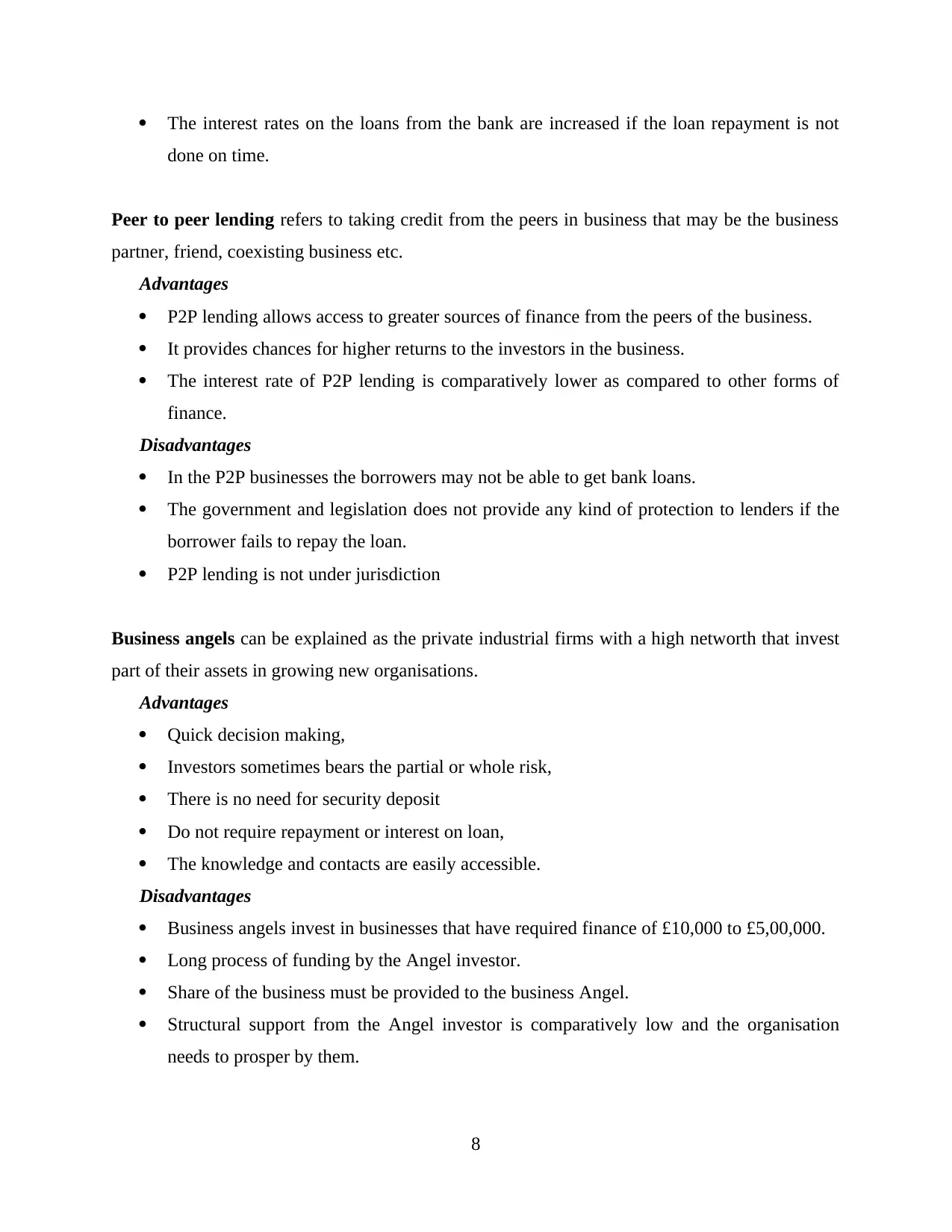
The interest rates on the loans from the bank are increased if the loan repayment is not
done on time.
Peer to peer lending refers to taking credit from the peers in business that may be the business
partner, friend, coexisting business etc.
Advantages
P2P lending allows access to greater sources of finance from the peers of the business.
It provides chances for higher returns to the investors in the business.
The interest rate of P2P lending is comparatively lower as compared to other forms of
finance.
Disadvantages
In the P2P businesses the borrowers may not be able to get bank loans.
The government and legislation does not provide any kind of protection to lenders if the
borrower fails to repay the loan.
P2P lending is not under jurisdiction
Business angels can be explained as the private industrial firms with a high networth that invest
part of their assets in growing new organisations.
Advantages
Quick decision making,
Investors sometimes bears the partial or whole risk,
There is no need for security deposit
Do not require repayment or interest on loan,
The knowledge and contacts are easily accessible.
Disadvantages
Business angels invest in businesses that have required finance of £10,000 to £5,00,000.
Long process of funding by the Angel investor.
Share of the business must be provided to the business Angel.
Structural support from the Angel investor is comparatively low and the organisation
needs to prosper by them.
8
done on time.
Peer to peer lending refers to taking credit from the peers in business that may be the business
partner, friend, coexisting business etc.
Advantages
P2P lending allows access to greater sources of finance from the peers of the business.
It provides chances for higher returns to the investors in the business.
The interest rate of P2P lending is comparatively lower as compared to other forms of
finance.
Disadvantages
In the P2P businesses the borrowers may not be able to get bank loans.
The government and legislation does not provide any kind of protection to lenders if the
borrower fails to repay the loan.
P2P lending is not under jurisdiction
Business angels can be explained as the private industrial firms with a high networth that invest
part of their assets in growing new organisations.
Advantages
Quick decision making,
Investors sometimes bears the partial or whole risk,
There is no need for security deposit
Do not require repayment or interest on loan,
The knowledge and contacts are easily accessible.
Disadvantages
Business angels invest in businesses that have required finance of £10,000 to £5,00,000.
Long process of funding by the Angel investor.
Share of the business must be provided to the business Angel.
Structural support from the Angel investor is comparatively low and the organisation
needs to prosper by them.
8
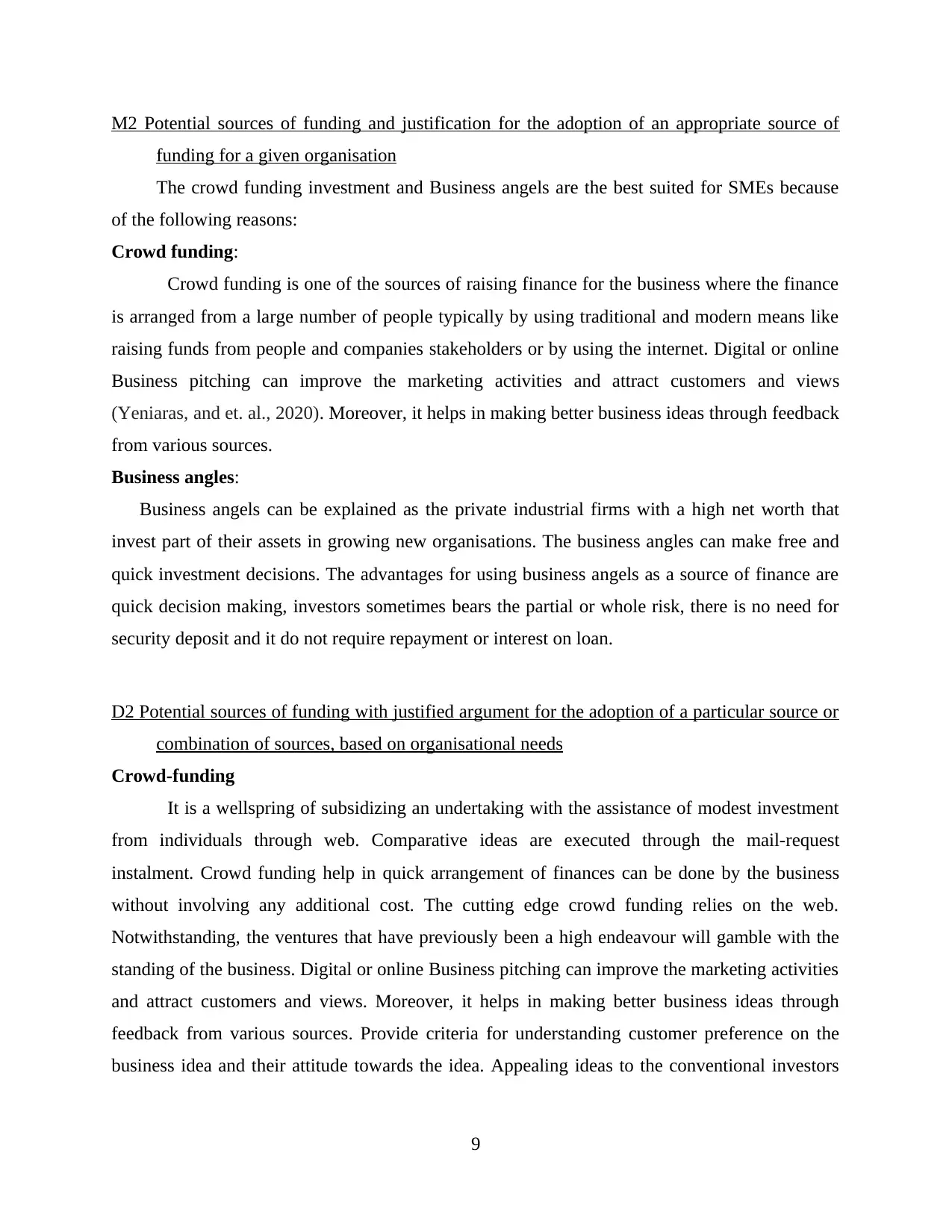
M2 Potential sources of funding and justification for the adoption of an appropriate source of
funding for a given organisation
The crowd funding investment and Business angels are the best suited for SMEs because
of the following reasons:
Crowd funding:
Crowd funding is one of the sources of raising finance for the business where the finance
is arranged from a large number of people typically by using traditional and modern means like
raising funds from people and companies stakeholders or by using the internet. Digital or online
Business pitching can improve the marketing activities and attract customers and views
(Yeniaras, and et. al., 2020). Moreover, it helps in making better business ideas through feedback
from various sources.
Business angles:
Business angels can be explained as the private industrial firms with a high net worth that
invest part of their assets in growing new organisations. The business angles can make free and
quick investment decisions. The advantages for using business angels as a source of finance are
quick decision making, investors sometimes bears the partial or whole risk, there is no need for
security deposit and it do not require repayment or interest on loan.
D2 Potential sources of funding with justified argument for the adoption of a particular source or
combination of sources, based on organisational needs
Crowd-funding
It is a wellspring of subsidizing an undertaking with the assistance of modest investment
from individuals through web. Comparative ideas are executed through the mail-request
instalment. Crowd funding help in quick arrangement of finances can be done by the business
without involving any additional cost. The cutting edge crowd funding relies on the web.
Notwithstanding, the ventures that have previously been a high endeavour will gamble with the
standing of the business. Digital or online Business pitching can improve the marketing activities
and attract customers and views. Moreover, it helps in making better business ideas through
feedback from various sources. Provide criteria for understanding customer preference on the
business idea and their attitude towards the idea. Appealing ideas to the conventional investors
9
funding for a given organisation
The crowd funding investment and Business angels are the best suited for SMEs because
of the following reasons:
Crowd funding:
Crowd funding is one of the sources of raising finance for the business where the finance
is arranged from a large number of people typically by using traditional and modern means like
raising funds from people and companies stakeholders or by using the internet. Digital or online
Business pitching can improve the marketing activities and attract customers and views
(Yeniaras, and et. al., 2020). Moreover, it helps in making better business ideas through feedback
from various sources.
Business angles:
Business angels can be explained as the private industrial firms with a high net worth that
invest part of their assets in growing new organisations. The business angles can make free and
quick investment decisions. The advantages for using business angels as a source of finance are
quick decision making, investors sometimes bears the partial or whole risk, there is no need for
security deposit and it do not require repayment or interest on loan.
D2 Potential sources of funding with justified argument for the adoption of a particular source or
combination of sources, based on organisational needs
Crowd-funding
It is a wellspring of subsidizing an undertaking with the assistance of modest investment
from individuals through web. Comparative ideas are executed through the mail-request
instalment. Crowd funding help in quick arrangement of finances can be done by the business
without involving any additional cost. The cutting edge crowd funding relies on the web.
Notwithstanding, the ventures that have previously been a high endeavour will gamble with the
standing of the business. Digital or online Business pitching can improve the marketing activities
and attract customers and views. Moreover, it helps in making better business ideas through
feedback from various sources. Provide criteria for understanding customer preference on the
business idea and their attitude towards the idea. Appealing ideas to the conventional investors
9
⊘ This is a preview!⊘
Do you want full access?
Subscribe today to unlock all pages.

Trusted by 1+ million students worldwide
1 out of 22
Related Documents
Your All-in-One AI-Powered Toolkit for Academic Success.
+13062052269
info@desklib.com
Available 24*7 on WhatsApp / Email
![[object Object]](/_next/static/media/star-bottom.7253800d.svg)
Unlock your academic potential
Copyright © 2020–2026 A2Z Services. All Rights Reserved. Developed and managed by ZUCOL.

